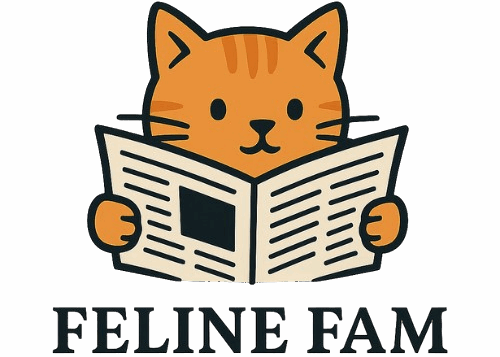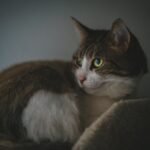Have you ever walked into a room and found your cat sprawled out, eyes closed, looking like the picture of peaceful slumber—only to notice a sneaky twitch of an ear or a sly peep from under their eyelids? If so, you’re not alone. Cats are master actors, and sometimes their sleeping act is just that: an act! Learning to spot when your feline friend is pretending to sleep can be both hilarious and revealing. Whether you’re a lifelong cat lover or a new pet parent, uncovering your cat’s little secrets brings you closer to understanding their quirky, mysterious world. Let’s dive into the subtle signals that separate the real catnaps from the Oscar-worthy performances.
The Classic Eye Peek

One of the most obvious signs your cat is faking sleep is the classic eye peek. Have you noticed your cat’s eyelids slightly open, just enough to keep track of your movements? This tiny slit is their window to the world while trying to convince you they’re sound asleep. It’s like when you were a kid, pretending to sleep so your parents would leave the room, but you couldn’t help but peek to see if they’d gone. Cats do it too, and sometimes you might catch a glint of their eye reflecting the light. If you approach, you might notice their eyes snap shut or their breathing pattern change—dead giveaways that the nap is nothing but a dramatic act.
Ear Movements That Give Them Away

A sleeping cat’s ears are usually relaxed and still. But if your cat’s ears twitch or swivel at the sound of a bag rustling or your voice, they’re probably not as asleep as they want you to believe. Cats have exceptional hearing, and even when “sleeping,” their ears serve as little radar dishes. A truly sleeping cat won’t react to every little sound, but one who’s pretending will keep those ears on high alert. Next time you walk by and accidentally knock something over, watch how your cat’s ears react—sometimes they’ll even flick towards you before the rest of their body “wakes up.”
Whisker Twitching and Facial Expressions

Whiskers are more than just adorable features—they’re sensitive tools that help cats sense everything around them. When a cat is genuinely asleep, their whiskers often relax. But if those whiskers twitch, quiver, or move ever so slightly while the rest of the body stays still, your cat is likely tuned in to the action around them. You might also see subtle changes in their mouth or nose—tiny movements that betray their alertness. It’s like seeing someone smile in their sleep, except with cats, that grin might mean, “I’m onto you.”
The Tail Tells All

A cat’s tail is a mood ring with fur. While most cats wrap their tails around themselves or let them lie limp when truly asleep, a cat who’s pretending might have a tail that flicks or twitches at sudden noises or movements. Sometimes, the tip will sway gently, as if the cat is trying to restrain their excitement or curiosity. If you see this, it’s a tell-tale sign your feline is more awake than they appear. It’s almost like their tail is having its own conversation with you, spelling out, “I see you, but I’m not moving—yet.”
Breathing Patterns: The Subtle Clue

When a cat is in deep sleep, their breathing will be slow, regular, and even. But a pretending cat’s breathing might be just a tad too controlled or shallow, as if they’re concentrating on keeping up the act. Some cats will even hold their breath for a moment if they hear something interesting, waiting to see if it’s worth “waking up” for. If you ever watch your cat closely and notice the rhythm of their chest doesn’t quite match a truly relaxed state, you’ve probably caught them in the act.
Paw Position and Muscle Tension

A truly relaxed cat lets their paws dangle or curl naturally, sometimes even twitching if they’re dreaming. But when a cat is faking it, you might notice a subtle tension in their paws or legs. Their claws might be slightly extended, or their muscles might look too tight for someone supposedly deep in slumber. Try gently touching their paw—if they pull away right away or tense up, chances are, they’re more awake than they look.
Sudden Head Movements

Cats are known for their lightning-fast reflexes, and even when “asleep,” a pretending cat will snap their head towards interesting sounds or sights. If you drop a toy or clap your hands, and your cat’s head jerks up (even if the rest of their body stays limp), you’ve uncovered their little ruse. This is their way of keeping tabs on what matters—food, fun, or simply you.
The Art of Selective Snoring

Some cats snore when they’re in a deep, restful sleep, but very few cats can fake a snore. If your cat usually snores and suddenly stops when you walk in, or if their “snoring” seems to come and go depending on the level of distraction in the room, it could be their version of method acting. Pay attention to changes in their usual sleep soundtrack—sometimes silence speaks volumes.
Response to Name or Favorite Words

Most cats know their names, even if they pretend not to. If you call your cat’s name or mention a favorite treat while they’re “sleeping,” watch for a flick of the ear, a twitch of the tail, or even a barely concealed smile. Some will keep up the act for a while, but the temptation to react can be too strong. It’s almost like a game of “Simon Says”—and cats love to win.
Unusual Sleep Locations

Cats are creatures of habit, and they often return to the same cozy spots for their true naps. But when your cat suddenly picks a spot in the center of the action—like the middle of the kitchen floor or right next to your workspace—they may be pretending to sleep just to keep an eye on you. It’s their way of saying, “I want to be where the action is, but don’t expect me to participate—at least, not yet.” If you notice your cat “sleeping” somewhere odd, consider what’s happening nearby.
The Disappearing Act: Instant Wakefulness

A genuinely sleeping cat takes a bit of time to wake up, stretching and yawning before moving. But a pretending cat is ready to leap into action in a split second. If your cat goes from “asleep” to fully alert faster than you can blink, chances are they weren’t really asleep at all. This instant transition is a classic sign that your cat was only pretending for their own reasons—maybe just to get a moment of peace, or perhaps to play a little trick on you.
Body Language: Too Perfectly Still

While deep sleep often brings about twitching paws, shifting bodies, or even soft murmurs, a cat who is pretending to sleep may be almost too still. If they seem as if they’re posing for a painting—body rigid, every whisker in place—they might just be holding their breath to see what happens next. That unnatural stillness is a dead giveaway that your cat is keeping tabs on their surroundings.
Reactions to Sudden Movements

Try dropping a sock or waving your hand in front of your “sleeping” cat. If their eyes snap open, ears perk up, or tail twitches, you’ve just caught them mid-act. Real sleep makes cats slow to respond, but a pretending cat is ready for action. It’s like living with a spy—they’re always on alert, just waiting for the next move.
Sleeping with One Eye Open—Literally!

Some cats have mastered the art of sleeping with one eye just barely open. This half-lidded gaze lets them monitor their kingdom without giving up the comfort of their nap spot. If you get close enough, you might spot a telltale glimmer from that “closed” eye. It’s a trick as old as time—a way to rest while staying ready for anything.
Changes in Routine or Behavior

If your usually playful cat suddenly spends a lot of time “asleep” but seems to be aware of everything happening, it could be a sign they’re not tired, but just uninterested or cautious. Maybe there’s a new pet in the house, or perhaps you’ve rearranged the furniture. Cats use fake sleep as a way to adapt to changes, observing from the sidelines without drawing attention to themselves.
Ignoring the Obvious Temptations

If your cat refuses to react to the sound of a can opener or the shake of a treat bag while “asleep,” but you notice their whiskers or tail twitch, they’re probably pretending. Most cats can’t resist their favorite treats, so ignoring these sounds is a classic sign they’re testing you—or just enjoying a little game of their own. It’s as if they’re saying, “I see you, but you have to try harder to get my attention!”
Kitten Copycats: When Young Cats Fake It Too

Even kittens can be little actors. Young cats love to mimic adult behavior, and if they see older cats pretending to sleep, they’ll give it a try, too. Watch for tiny, twitching bodies or restless paws—kittens are usually too energetic to keep up the charade for long. Their fake naps are often interrupted by sudden bursts of play, revealing their true colors.
That’s how you can spot a cat who’s pretending to sleep.

Growing up traveling and experiencing new cultures and wonders, I have had a passion for nature, adventuring, photography, and videography. I am currently working towards a BSc in Biodiversity and Ecology at Stellenbosch University, and I hope to specialise in Marine Sciences one day.
Please send any feedback to Feedback@animalsaroundtheglobe.com






